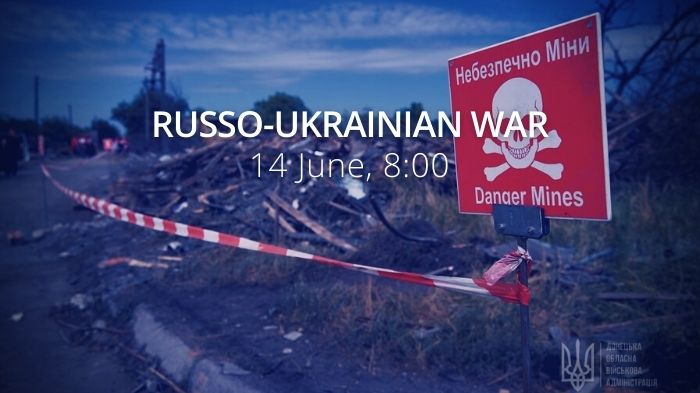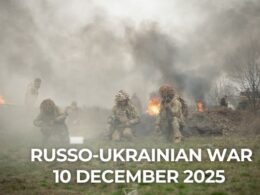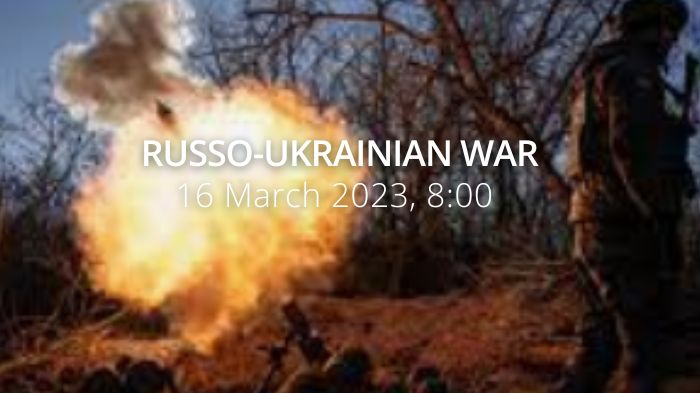Ukraine's limited counteroffensive in Kherson Oblast stalled as the fiercest battles are raging on in the Donbas and Ukraine urges the West to send more heavy weapons. Russia slowly advances from the north of Kharkiv Oblast, trying to push the Ukrainian troops away from the border, has recaptured the center of Sievierodonetsk, destroyed the last bridge connecting Sievierodonetsk to Lysychansk, and tries to advance towards Sloviansk. Russia's aggression can push 49 million people into famine. Ukrainian law enforcement officers find several bodies every week in mass graves. Pope Francis has chided Russia for the "brutality" shown by its troops. The EU cut off three more Russian banks from SWIFT, including Russia's largest bank Sberbank.
Operational situation
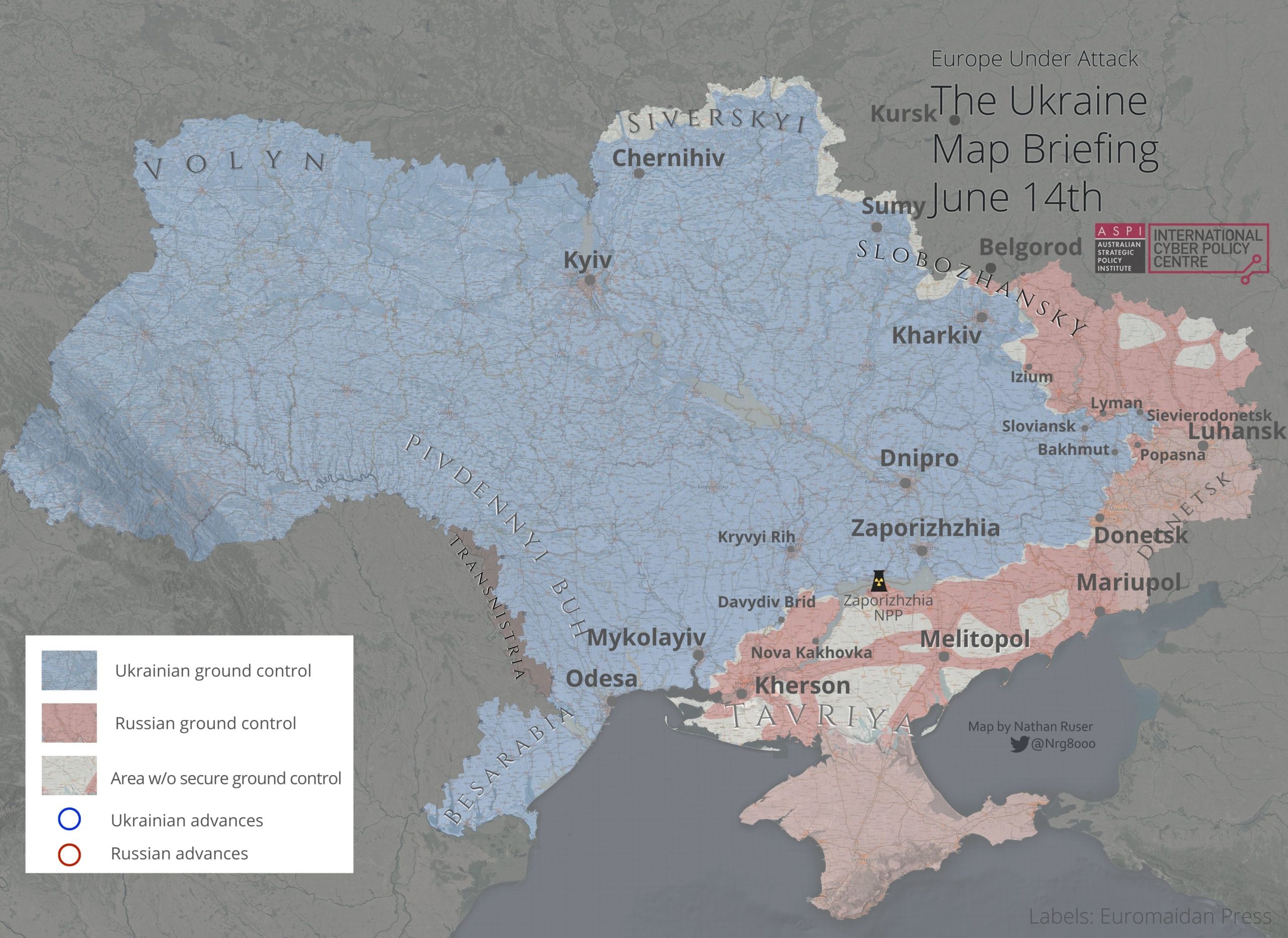
An overview of the latest military events as per military expert Roman Ponomarenko:
Currently, the Russian-Ukrainian front line stretches 2,450 km, of which 1,105 km see the active fighting. The fiercest battles are taking place in Luhansk Oblast and at Sloviansk.
The Russians continue to press in Kharkiv Oblast, having captured Borshchova and now advancing from there on Ruski Tyshky, and, from occupied Ternova, on Bairak. The Russian troops are unlikely going to storm Kharkiv now lacking enough forces for that.
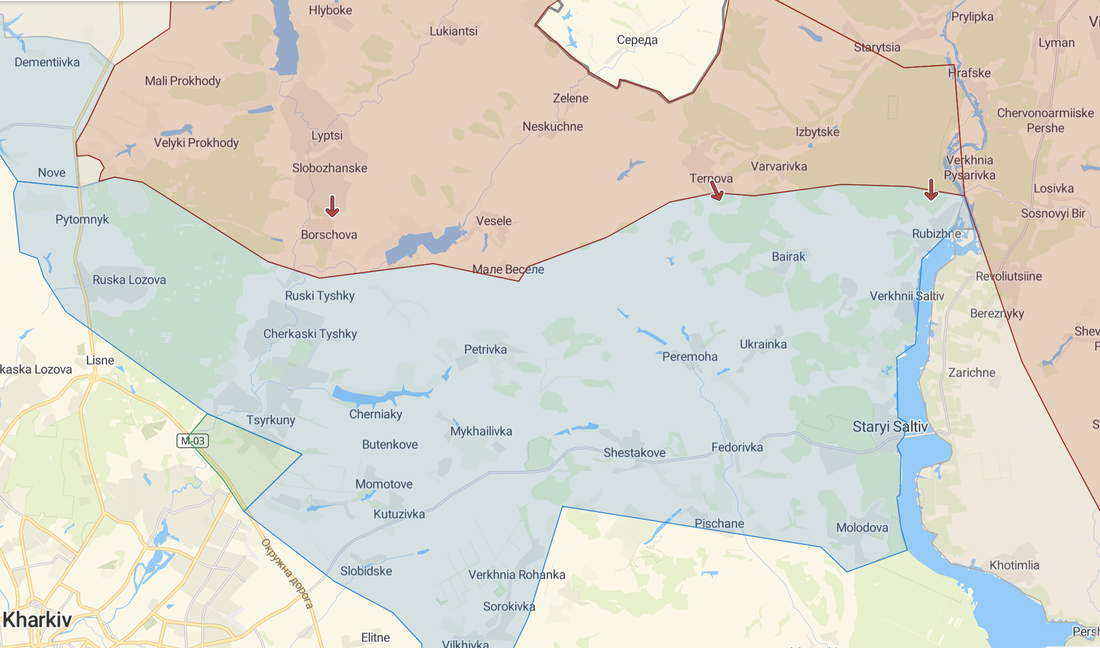
On 12 June, the Russians claimed the capture of the militarily important village of Bohorodychne, northeast of Sloviansk, but on the next day, Ukraine's General Staff refuted this statement, noting that the fighting is taking place inside the village with the Russians having gained a foothold in its northwestern part. The battles for and around Bohorodychne have been going on for three weeks now.
Fighting is also raging for Dolyna, an important village west of Bohorodychne. Against these two villages, Russia deployed 5-6 battalion-tactical groups (BTGs). To the north of Sloviansk, in the Dovhenke-Tykhotske-Pasyka area, the Russians concentrated an even more powerful group of troops, up to 9 BTGs. Another 5 BTGs operate in the Barvinkove direction. Also, 10-12 artillery divisions, assault aircraft, and attack helicopters support this grouping.
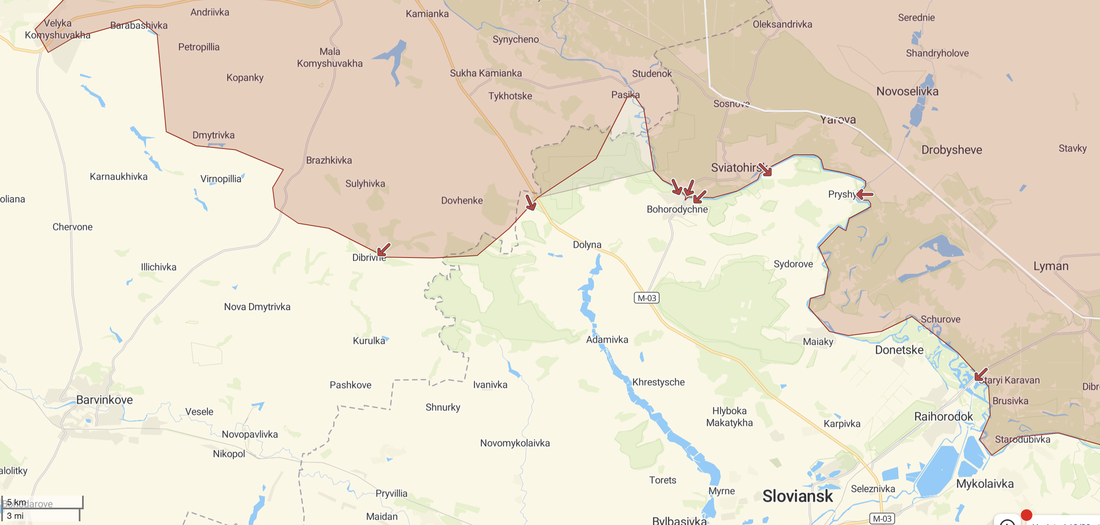
In Luhansk Oblast, late on June 12, the Russian troops destroyed the last third bridge connecting Sievierodonetsk with Lysychansk, yet the next morning Oblast Head Serhii Haidai stated that "there is no encirclement threat for our troops in Luhansk Oblast," also noting that Russians control 70% of the city. The Ukrainian army retains control of the village of Metiolkine south of Sievierodonetsk. The nearby city of Lysychansk is under fire with fighting on the southern approaches to it.
The situation around occupied Popasna, Luhansk Oblast, didn't change much. Ukrainian forces continue to repel enemy attacks in the areas of Vrubivka, Hirske, and Zolote while the key highway to Lysychansk also remains under Ukrainian control.
Ukrainian fire stopped Russian attempts at attacking Bakhmut, Soledar, and other key points in Donetsk oblast.
In southern Kherson Oblast, the Ukrainian limited counteroffensive has stalled due to the insufficient resources involved in the operation.
Day 111 report – June 14
Information from the General Staff as of 06.00 14.06.2022, supplemented by its [18:00 assessment], is in the drop-down menu.
In the Volyn and Polissia directions, no significant changes in the activities of [Belarusian] units were observed.
In the Siverskyi direction, Russian forces reinforced units of the 1st Tank Army of the Western Military District, which is involved in covering the Russian-Ukrainian border in Bryansk and Kursk oblasts, with two battalion tactical groups
of airborne troops. The aggressor fired artillery at the [Ukrainian] positions in the border areas of Sumy and Chernihiv oblasts and conducted air reconnaissance with UAVs in the area of the settlement of Seredyna Buda, Sumy Oblast.
[Slobozhanskyi direction]:
- In the Kharkiv direction, [Russia's] main efforts are focused on conducting positional defense and preventing the further advance of [Ukrainian] units to the state border. The invaders opened fire on the areas of the settlements of Rubizhne, Ruska Lozova, Bayrak, and Dementiivka, also using combat aircraft
https://twitter.com/EuromaidanPress/status/1536689410296586241
- In the Sloviansk direction, Russian invaders are focusing their efforts on establishing full control over the settlement of Bohorodychne and creating conditions for the development of the offensive on Sloviansk. The enemy used artillery near Dibrivne, Karnaukhivka, Nova Dmytrivka, and Vernopil.
[Donetsk direction:]
- In the Lyman direction, Russian invaders are regrouping troops in order to develop an offensive in the directions Lyman - Raihorodok and Yampil - Siversk.
- In the Sievierodonetsk direction, [Russian forces] strengthened the group of forces by moving up to two battalion tactical groups to the area of settlements Kreminna-Rubizhne. With the support of artillery, it carried out assault operations in the city of Sievierodonetsk, trying to gain a foothold in the central part of the city.
- In the Bakhmut direction, [Russian forces] fired artillery at the positions of our troops in the areas of the settlements of the Vidrodzhennia, Novoluhanske, and Bakhmut, had partial success, fixed in the settlement of the Vidrodzhennia, continues to carry out assault operations in the direction of the Vidrodzennia-Vershyna.
- In the Avdiivka, Kurakhoveka, Novopavlivka, and Zaporizhzhia directions, the Russian enemy didn't take active action. Increased the use of aircraft and artillery to bind [Ukrainian] troops.
Ukrainian artillery destroys Russian equipment
The Ukrainian 40th Separate Artillery Brigade named after Grand Duke Vitovt shared a video of a Russian BMP-2 and another vehicle being destroyed by a Ukrainian artillery strike. https://t.co/ih2sytcC1e pic.twitter.com/aM5cIzCQwQ
— Euromaidan Press (@EuromaidanPress) June 14, 2022
In the Pivdennyi Buh direction, the invaders are concentrating their main efforts on maintaining the occupied borders and preventing our troops from conducting counter-offensive operations.
In the Kryvyi Rih direction, the enemy mined the coast of the Inhulets River along the Davydiv Brid-Kalynivske border.
In the Mykolayiv direction, in the areas of the settlements of Stanislav, Tomyna Balka, and Doslidne in Kherson oblast, the enemy deployed up to two MLRS batteries and one artillery battery.
Five carriers of naval-based Caliber cruise missiles in the Black Sea are ready to use missiles.
According to British Defense Intelligence:
- As of 14 June, Russia's operational main effort remains the assault against the Sievierodonetsk pocket in the Donbas and its Western Group of forces have likely made small advances in the Kharkiv sector for the first time in several weeks.
- On 10 June, the First Deputy Chairman of Russia's Military-Industrial Commission predicted that state defense spending will increase by 600-700 billion rubles ($10.2-11.9 bn), which could approach a 20% increase in Russia's defense budget.
- Russian government funding is allowing the country's defense industrial base to be slowly mobilized to meet demands placed on it by the war in Ukraine. However, the industry could struggle to meet many of these requirements, partially due to the effects of sanctions and lack of expertise. Russia's production of high-quality optics and advanced electronics likely remain troubled and could undermine its efforts to replace equipment lost in Ukraine.
In Zaporizhzhia Oblast, Ukraine, and Russia swapped bodies of soldiers
, UkrInform reported. The bodies of 64 more fallen Azovstal defenders were returned to Ukraine.
As of 14 June 2022, the approximate losses of weapons and military equipment of the Russian Armed Forces from the beginning of the war to the present day:
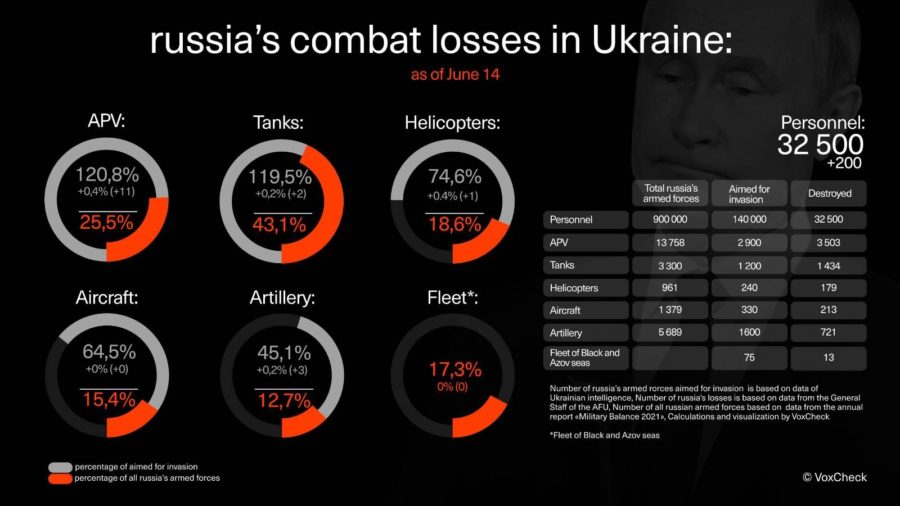
Russian enemy suffered the greatest losses (of the last day) in the Bakhmut direction.
Humanitarian
- Russia's aggression can push 49 million people into famine, CNN reported. "This is a cold, callous, calculated siege on some of the most vulnerable countries. Food became part of Kremlin terror arsenal," von der Leyen said. UN's program to fight food insecurity buys half of its wheat from Ukraine.
- The future of global security will be decided in Ukraine, says Ukrainian Defense Minister Oleksii Reznikov in his op-ed on Atlantic Council:
"NATO leaders will gather in the Spanish capital at the end of June for a potentially historic summit. They are expected to approve a landmark new Strategic Concept at a time when the Russian invasion of Ukraine has created the most dramatic international security challenges for a generation. The choices made in Madrid will likely shape the geopolitical agenda for decades to come.
"If NATO’s new Strategic Concept has no clear place in it for Ukraine, the document will be divorced from today’s security realities and dead on arrival. This would be a victory for inertia and a green light for dictators like Putin to pursue aggressive foreign policies. The entire world would become a far more dangerous place.
"By the time the NATO summit gets underway in Spain, Russia’s full-scale invasion of Ukraine will have entered its fifth month. This invasion has already imposed staggering costs on the Ukrainian people and transformed the geopolitical landscape. By demonstrating strong leadership, NATO members can determine the outcome of the war and define the future of global security."
- Ukrainian grain shippers have carved out a fresh export route -- via the Baltic Sea -- to send their crops abroad, Bloomberg reports. "The country has been hunting for alternative paths for its crops as the war with Russia cuts off vital shipments from ports dotting the Black Sea, stoking global food prices and raising worries over hunger. Producers have resorted to sales by land instead, ferrying grain by railway, road, and river to European Union neighbors."
- Millions of refugees from Ukraine have crossed borders into neighboring countries, and many more have been forced to move inside the country. The escalation of conflict in Ukraine has caused civilian casualties and destruction of civilian infrastructure, forcing people to flee their homes seeking safety, protection, and assistance the UNHCR reports. They need protection and support. As of 13 June:
- Individual refugees from Ukraine recorded across Europe: 4,904,207.
- Refugees from Ukraine registered for Temporary Protection or similar national protection schemes in Europe: 3,206,642.
- Border crossings from Ukraine (since 24 February 2022): 7,514,460
- Border crossings to Ukraine (since 28 February 2022): 2,479,398
- OHCHR recorded 9,931 civilian casualties in Ukraine as of June 14. 4,432 were killed (including 277 children) and 5,499 injured (including 312 children).
Environmental
- Ukraine's national seed bank with almost 2,000 crop samples was partly destroyed amid fighting. "One important lesson from the war in Ukraine is that enormous work of peasant farmers in Ukraine and elsewhere farming on small plots deserves more attention."
Legal
- Another grave has been uncovered near Myrotske, Kyiv oblast, where the Russian military was positioned while advancing on Kyiv. Andriy Niebytov, Head of the Kyiv Regional Police, reported on 13 June that the mass grave contained the bodies of seven civilians, all of them shot in the head.
- Ukrainian law enforcement officers find several bodies every week in mass graves in the territory liberated from Russian troops, according to Ukraine's National Police Head. 1,500 civilians were killed by Russian troops in Kyiv Oblast alone, 1,200 bodies have not yet been identified, Police investigate criminal proceedings over the deaths of over 12,000 civilians.
- Russian troops stole almost 2,000 tons of grain in Zaporizhzhia oblast, according to the Prosecutor General's Office of Ukraine. The office says it investigates 2 relevant criminal cases of violations of the laws and customs of war in the region.
- The American banks JPMorgan and Goldman halted Russian debt trading, according to Bloomberg citing sources. The halt came following the last week's US ban for investors from buying Russian debt and stocks on the secondary market.
- The EU cut off three more Russian banks from SWIFT, BBC Russia reported. Starting June 14, the EU removed from the SWIFT system the largest Russian bank Sberbank, as well as Rosselkhozbank and the Moscow Credit Bank as part of the sixth package of sanctions against Russia
- Pope Francis has chided Russia for the "brutality" shown by its troops in the war it launched against Ukraine, which has been "brave" in its fight to defend itself, RFE/RL reports. "What we are seeing is the brutality and ferocity with which this war is being carried out by the troops, generally mercenaries, used by the Russians," the pontiff said in a talk with Jesuit media members, which took place last month and was published on June 14."
- Amnesty International accused Russia of war crimes during its efforts to seize Kharkiv. Its new 40-page report documents the use of cluster munitions, the repeated bombing of residential areas, using PTM-1S (scatterable anti-pers mine)."People were killed in homes, streets, playgrounds, cemeteries."
Support
- The US is sending more rocket systems to Ukraine, a senior Pentagon official says, according to The Washington Post. "Colin Kahl, US undersecretary of defense for policy, said during a security conference held by the Center for a New American Security in Washington that it is “absolutely fair” to say that the four M142 High Mobility Artillery Rocket Systems, or HIMARS, sent to Ukraine so far are only a starting point."
- The US expects more announcements of weapons and equipment packages to be sent to Ukraine to help in its fight against Russia at a meeting of nearly 50 countries in Brussels on 15 June, according to CNN citing a senior US defense official.
Assessment
1. On the War
The Institute for the Study of War has made the following assessment as of 13 June:
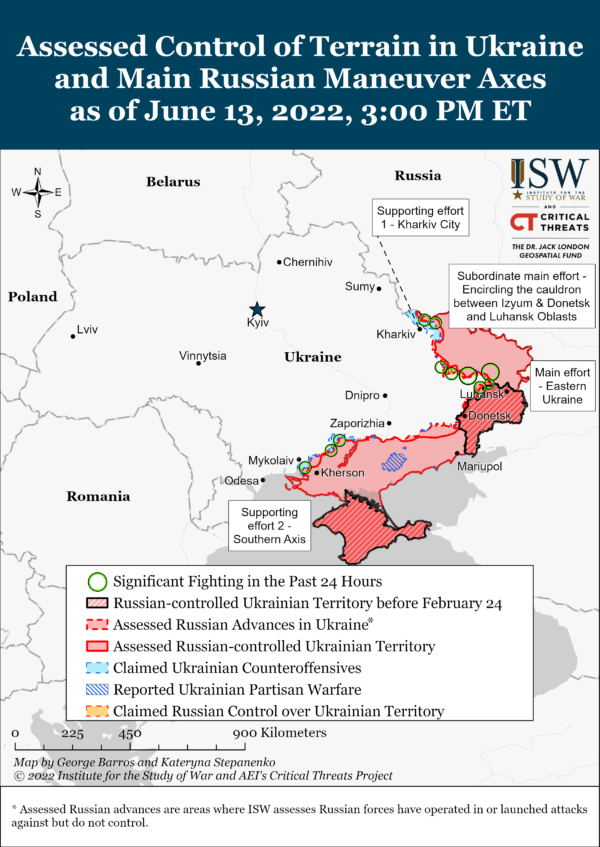
Kremlin-sponsored outlet Izvestia published and quickly removed an appeal by the First Deputy Head of the Russian Presidential Administration Sergey Kirelenko for Russia to rebuild the Donbas on June 12 and blamed hackers for what they (likely falsely) claimed was a “fake publication.” Izvestia likely intended to save the article for a later date to set informational conditions for the Russian annexation of Donbas. Kirelenko's appeal stated that Russia will restore the Donbas regardless of high costs or if doing so lowers the standard of living in Russia. Izvestia blamed unknown hackers for publishing a “fake article,” but it is possible that hackers instead released an article Izvestia had prepared to publish at a later date. The Kremlin previously published and removed an article prematurely celebrating a Russian victory over Ukraine in late February and discussing the capture of Ukraine in the past tense in anticipation of Ukraine’s capitulation during the first Russian-Ukrainian negotiations in Belarus. Unnamed Kremlin officials previously identified Kirelenko as the future head of a new Russian federal district, which would encompass Donbas, and occupied settlements in Kherson and Zaporizhzhia Oblasts.
Russia continues to deploy insufficiently prepared volunteer and reserve forces to reinforce its ongoing operations. Kremlin-sponsored outlet Izvestia released footage showing Russian artillery reservists undergoing training with old D-20 howitzers reportedly within 10 days of their deployment to Ukraine. The reservists focused on learning how to operate hand-held weapons, despite being reportedly only days away from deploying. Social media footage also showed Russian forces transporting Russian volunteer and reserve units with T-80BV tanks (a variant produced in 1985, as opposed to the modernized T-80 BVM operated by the 1st Guards Tank Army) and BMP-1 armored personnel carriers (which have largely been phased out in favor of the BMP-2) to Belgorod Oblast on June 9. Additional social media footage showed Russian forces transporting T-80BV tanks removed from storage in Moscow Oblast on June 9.
Key Takeaways
- Russian forces pushed Ukrainian defenders from the center of Severodonetsk and reportedly destroyed the remaining bridge from Sievierodonetsk to Lysychansk on June 13, but Ukrainian officials reported that Ukrainian forces are not encircled in the city.
- Russian forces carried out unsuccessful ground assaults in an attempt to sever Ukrainian ground lines of communications (GLOCs) near Popasna and Bakhmut.
- Russian forces launched unsuccessful offensive operations southeast of Izium and north of Sloviansk, and are likely setting conditions for an assault on Siversk and northwestern Ukrainian GLOCs to Lysychansk.
- Russian forces are likely conducting a limited offensive directly northeast of Kharkiv City in a likely attempt to push Ukrainian forces out of artillery range of Russian rear areas and secured some successes.
- Russian and Ukrainian forces are engaging in ongoing fighting for Davydiv Brid in northwestern Kherson Oblast.
- Russian occupation authorities likely staged terrorist activity in Melitopol and Berdiansk for Russia Day on June 12.
2. Consequences and what to do?
- "[German Chancellor] Scholz and his government have to make a decision. No balancing should be attempted between Ukraine and Russia," President Volodymyr Zelenskyy told ZDF. "The federal government should be more tough towards Russia, even if it damages the German economy."
- Europe must arm Ukraine faster, urges its defense minister: "Give us the tools and we’ll finish the job," says Oleksii Reznikov in his interview with The Economist.

